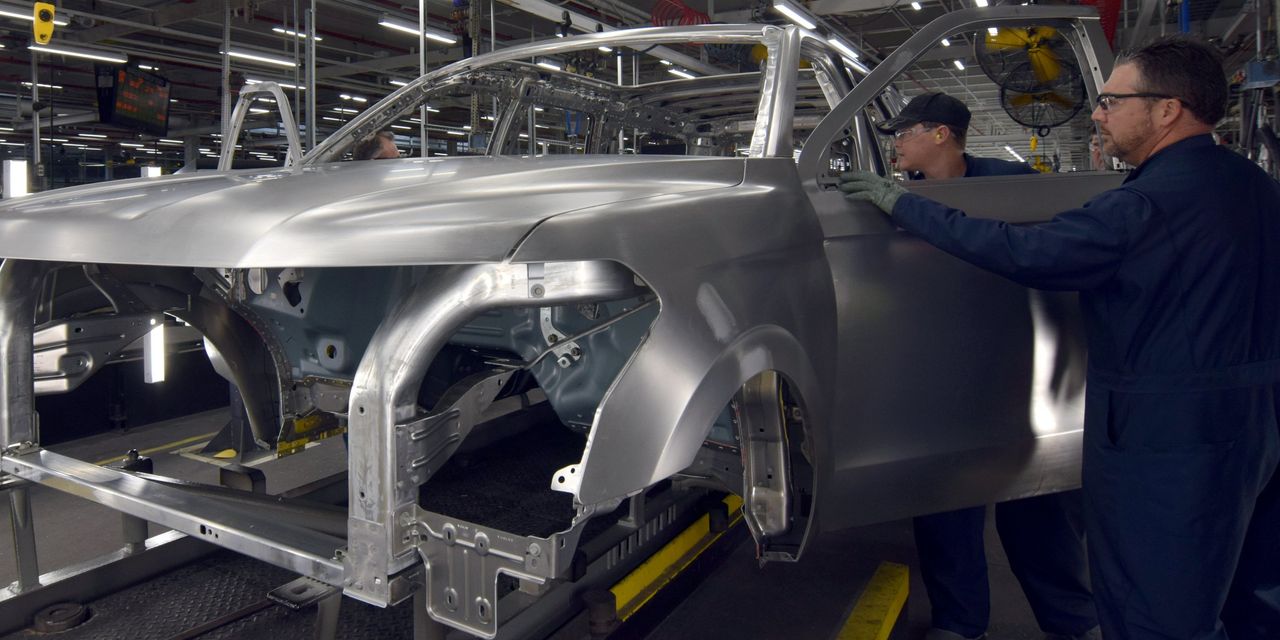
Ford Motor Co. F 2.76% plans to build its first new U.S. assembly plant in decades, along with three battery factories, to fortify its push into electric vehicles as the industry accelerates green-tech investments.
The Dearborn, Mich., auto maker said Monday that it would build two battery factories in Kentucky and a third in western Tennessee alongside a new truck factory set to begin producing electric F-series pickups by 2025.
Ford F 2.76% expects to spend $7 billion on the project—the largest manufacturing investment in its history—and collaborate with South Korean battery maker SK Innovation to construct the battery facilities.
SK plans to put $4.4 billion into the effort, which altogether would create 11,000 new jobs and provide enough capacity to build batteries for 1 million electric vehicles a year, the companies said.
The move amounts to a major bet on electric cars as the company and other traditional auto makers try to compete with EV leader Tesla Inc., even as large, gas-powered trucks and SUVs continue to fuel their profits.
Only a few new auto-assembly plants have been built in the U.S. over the last few decades, including a Volvo factory in South Carolina and a recently opened one in Detroit that makes Jeep models.
Ford Chief Executive Jim Farley said Ford decided to move ahead with the new plants in part because of a strong reception to early electric offerings such as the Mustang Mach-E sport-utility vehicle.
“We’re speeding up this enormous investment,” Mr. Farley said in an interview. “We’re actually spending the money, building the buildings, insourcing the batteries. That’s a significant strategic change over supply-chain management.”
The two companies’ combined $11.4 billion investment underscores the large financial stakes involved in betting on a technology that, while growing rapidly, still represents only about 3% of the industry’s U.S. sales. Overall, Ford has committed to spend $30 billion on electric vehicles through 2025, with some of that already spent and a figure roughly on par with its automotive rivals.
It also signals Ford isn’t ceding this ground to rival General Motors Co. , which was earlier to pledge shifting to electrics and committing to produce its own batteries. Mr. Farley, who took the top job a year ago, has been working to boost profitability, which has lagged behind GM, while outlining a growth strategy built around electric and digitally connected cars.
Because electric cars remain more expensive relative to gasoline-powered cars, their adoption has partly relied on federal and state subsidies to entice buyers. Analysts say a relative dearth of charging stations and the potential difficulty of accessing raw battery materials, like cobalt and lithium, also loom as potential drags on greater electric-vehicle uptake.
Still, stricter global limits on tailpipe emissions have prodded car companies to expand their efforts on battery-powered vehicles. Auto executives increasingly say they see electric vehicles and related digital services a growth opportunity at a time when Tesla and some EV startups have attracted dizzying valuations.
Additionally, major car companies are rushing to get into the battery business through joint ventures with major producers, such as SK Innovation, Panasonic and LG Energy Solution.
In a move pioneered by Tesla, many car companies are bringing more of the development and manufacturing in house to access technical expertise and lower costs.
The Biden administration also is pushing for more federal spending to support a broad expansion of electric vehicles, including new charging stations and greater enticements for consumers to buy plug-in cars. Congressional Democrats have proposed extra consumer tax credits for electrics that are built by union labor.
As auto manufacturers invest more in EV technologies, Tennessee is among the states drawing attention lately. GM plans to build a $2.3 billion battery factory south of Nashville to support a nearby assembly plant, which itself is getting a $2 billion makeover to make electrics. Volkswagen AG is spending $800 million to expand its Chattanooga, Tenn., factory for electric-car production.
Ford executives say they are seeing higher-than-expected demand for a forthcoming electric F-150 pickup truck, called the Lightning, collecting more than 150,000 nonbinding reservations since it was unveiled in May.
Building a new assembly factory, which can typically produce a few hundred thousand vehicles a year, can be risky. Detroit auto makers especially have been plagued by excess factory capacity over the decades, amid booms and busts in the economic cycle for new cars. Many older auto factories were mothballed around the financial crisis and the bankruptcies of GM and Chrysler Corp.
Mr. Farley said the new assembly plant required a fresh site, partly so Ford could move quickly without the cleanup and renovation that would be needed to retrofit an existing facility. He also cited the region’s proximity to other Ford plants and lower energy costs. Battery plants use many times more energy in their operations than traditional auto-assembly plants, he said.
Size was also a factor, he said. Covering nearly 6 square miles, the Tennessee complex would be roughly three times the size of Ford’s River Rouge plant complex near its Dearborn headquarters.
The EV transition is expected to put factory jobs at risk, union leaders say, because they require fewer parts and less manpower to assemble than gas- or diesel-powered cars. The United Auto Workers and unions in Europe have warned that tens of thousands of jobs could be lost as the switch unfolds over the next decade.
Battery factories could help offset any potential job losses, although it isn’t known whether jobs at these future facilities will be unionized. They are expected to offer lower wages than those at UAW-represented factories.
John Savona, Ford’s vice president of manufacturing and labor affairs, told reporters that future workers at the assembly factory and the three battery plants would decide whether to be represented by a union.
Write to Mike Colias at [email protected]
Copyright ©2021 Dow Jones & Company, Inc. All Rights Reserved. 87990cbe856818d5eddac44c7b1cdeb8








